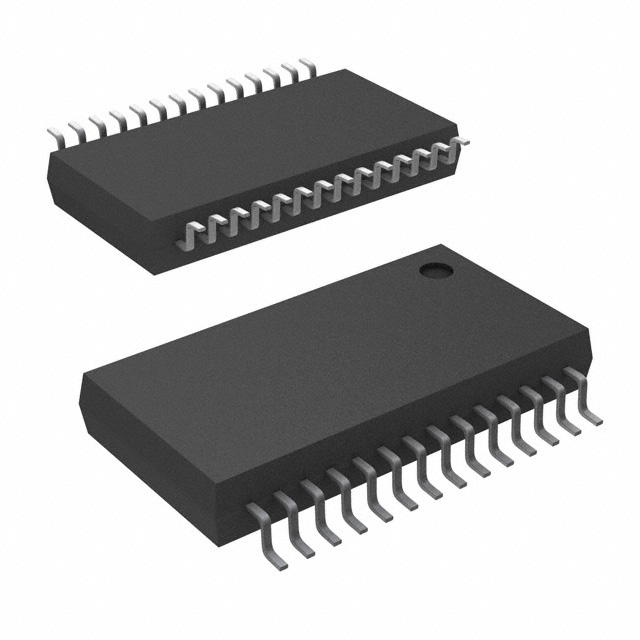MAX3237ECDBR
Product Overview
- Category: Integrated Circuit (IC)
- Use: RS-232 Transceiver
- Characteristics:
- High-speed, low-power transceiver
- Supports data rates up to 1 Mbps
- Operates from a single 3.0V to 5.5V power supply
- Compatible with EIA/TIA-232 and V.28/V.24 communication standards
- Package: 28-pin SSOP (Shrink Small Outline Package)
- Essence: MAX3237ECDBR is a versatile RS-232 transceiver IC that enables bidirectional communication between microcontrollers or other digital devices and RS-232 serial interfaces.
- Packaging/Quantity: Available in tape and reel packaging, with 2500 units per reel.
Specifications
- Supply Voltage Range: 3.0V to 5.5V
- Data Rate: Up to 1 Mbps
- Number of Channels: 2
- Operating Temperature Range: -40°C to +85°C
- Package Type: SSOP-28
Pin Configuration
The MAX3237ECDBR has a total of 28 pins. The pin configuration is as follows:
Pin 1: VCC
Pin 2: C1-
Pin 3: C1+
Pin 4: V+
Pin 5: T1OUT
Pin 6: R1IN
Pin 7: R1OUT
Pin 8: T1IN
Pin 9: GND
Pin 10: SHDN
Pin 11: R2IN
Pin 12: R2OUT
Pin 13: T2IN
Pin 14: T2OUT
Pin 15: V-
Pin 16: C2+
Pin 17: C2-
Pin 18: VCC
Pin 19: C1-
Pin 20: C1+
Pin 21: V+
Pin 22: T1OUT
Pin 23: R1IN
Pin 24: R1OUT
Pin 25: T1IN
Pin 26: GND
Pin 27: SHDN
Pin 28: R2IN
Functional Features
- High-Speed Transceiver: The MAX3237ECDBR supports data rates up to 1 Mbps, making it suitable for applications requiring fast serial communication.
- Low Power Consumption: This IC operates from a single power supply and consumes minimal power, making it energy-efficient.
- EIA/TIA-232 Compatibility: It is fully compatible with the EIA/TIA-232 and V.28/V.24 communication standards, ensuring seamless integration with existing RS-232 interfaces.
Advantages and Disadvantages
Advantages: - High-speed data transmission - Low power consumption - Wide operating voltage range - EIA/TIA-232 compatibility
Disadvantages: - Limited number of channels (2)
Working Principles
The MAX3237ECDBR is designed to convert TTL/CMOS logic levels to RS-232 voltage levels and vice versa. It utilizes internal charge pumps to generate the required RS-232 voltage levels, eliminating the need for external components. The transceiver enables bidirectional communication by converting the digital signals from microcontrollers or other devices to RS-232 voltage levels suitable for transmission over long distances.
Detailed Application Field Plans
The MAX3237ECDBR is widely used in various applications that require RS-232 communication, including:
- Industrial Automation: Used for connecting PLCs (Programmable Logic Controllers) to computer systems or human-machine interfaces.
- Networking Equipment: Enables communication between routers, switches, and other network devices using RS-232 interfaces.
- Point-of-Sale Systems: Facilitates communication between cash registers, barcode scanners, and other peripherals.
- Medical Devices: Used in medical equipment for data transfer and control purposes.
- Test and Measurement Instruments: Enables serial communication with devices such as oscilloscopes, spectrum analyzers, and data loggers.
Detailed and Complete Alternative Models
- MAX3232ECDR: Similar to MAX3237ECDBR, but with a smaller package (SOIC-16) and lower data rate (250 kbps).
- MAX232CPE: A popular RS-232 transceiver IC with similar functionality, but operates at lower data rates (up to 120 kbps).
These alternative models can be considered based on specific application requirements, package size constraints, and desired data rates.
Word count: 525 words
Senaraikan 10 soalan dan jawapan biasa yang berkaitan dengan aplikasi MAX3237ECDBR dalam penyelesaian teknikal
Sure! Here are 10 common questions and answers related to the application of MAX3237ECDBR:
Q: What is the MAX3237ECDBR? A: The MAX3237ECDBR is a high-speed, low-power RS-232 transceiver IC.
Q: What is the operating voltage range of the MAX3237ECDBR? A: The operating voltage range is typically between +3.0V and +5.5V.
Q: Can the MAX3237ECDBR be used for both transmitting and receiving data? A: Yes, it can be used for both transmitting and receiving RS-232 signals.
Q: What is the maximum data rate supported by the MAX3237ECDBR? A: The maximum data rate supported is up to 250 kbps.
Q: Does the MAX3237ECDBR require external capacitors? A: Yes, it requires external capacitors for charge pump operation.
Q: Can the MAX3237ECDBR be used in industrial applications? A: Yes, it is suitable for use in industrial environments due to its robustness and ESD protection.
Q: Is the MAX3237ECDBR compatible with TTL logic levels? A: Yes, it is compatible with both TTL and CMOS logic levels.
Q: Can the MAX3237ECDBR be used with microcontrollers or Arduino boards? A: Yes, it can be used with microcontrollers and Arduino boards that have UART interfaces.
Q: Does the MAX3237ECDBR support full-duplex communication? A: Yes, it supports full-duplex communication, allowing simultaneous transmission and reception.
Q: Are there any specific layout considerations for using the MAX3237ECDBR? A: Yes, it is recommended to follow the layout guidelines provided in the datasheet to ensure optimal performance and minimize noise.
Please note that these answers are general and may vary depending on the specific application and requirements. It is always recommended to refer to the datasheet and consult with the manufacturer for detailed information.


